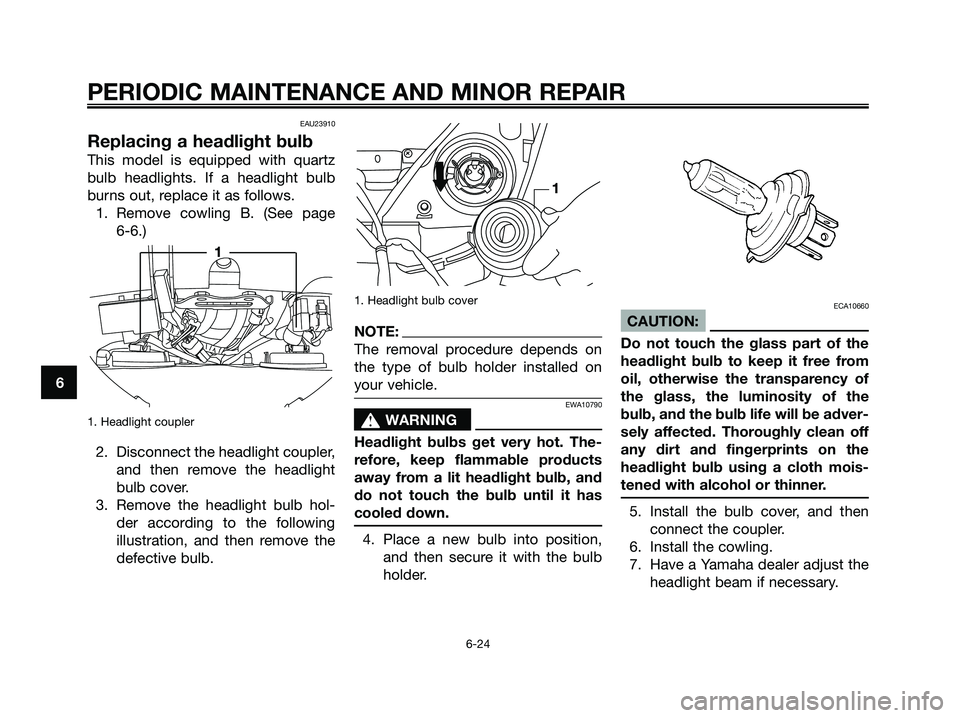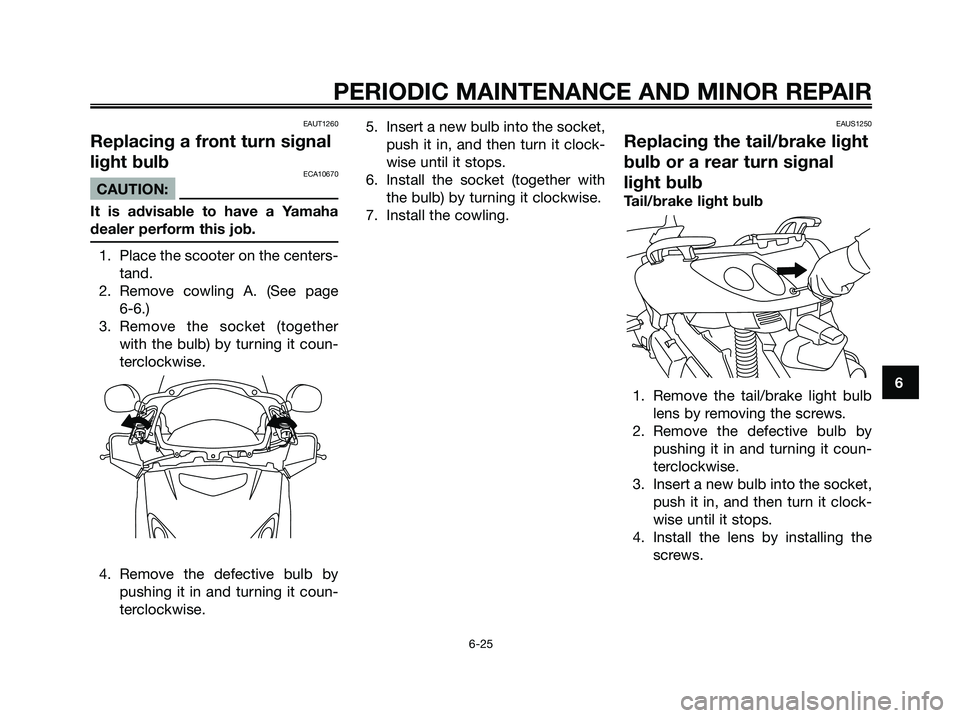Page 57 of 76
2. While applying the front brake,
push down hard on the handle-
bars several times to check if the
front fork compresses and
rebounds smoothly.
ECA10590
CAUTION:
If any damage is found or the front
fork does not operate smoothly,
have a Yamaha dealer check or
repair it.
EAU23280
Checking the steering
Worn or loose steering bearings may
cause danger. Therefore, the opera-
tion of the steering must be checked
as follows at the intervals specified in
the periodic maintenance and lubrica-
tion chart.
1. Place a stand under the engine to
raise the front wheel off the
ground.
EWA10750
s s
WARNING
Securely support the motorcycle so
that there is no danger of it falling
over.
2. Hold the lower ends of the front
fork legs and try to move them
forward and backward. If any freeplay can be felt, have a Yamaha
dealer check or repair the stee-
ring.
6
PERIODIC MAINTENANCE AND MINOR REPAIR
6-21
1B9-F8199-E0.qxd 14/10/2005 11:07 Página 57
Page 58 of 76

EAU23290
Checking the wheel bearings
The front and rear wheel bearings
must be checked at the intervals spe-
cified in the periodic maintenance and
lubrication chart. If there is play in the
wheel hub or if the wheel does not
turn smoothly, have a Yamaha dealer
check the wheel bearings.
EAU23380
Battery
The battery is located behind panel A.
(See page 6-6.)
This model is equipped with a sealed-
type (MF) battery, which does not
require any maintenance. There is no
need to check the electrolyte or to
add distilled water.
ECA10620
CAUTION:
Never attempt to remove the bat-
tery cell seals, as this would per-
manently damage the battery.
EWA10760
s s
WARNING
�Electrolyte is poisonous and
dangerous since it contains
sulfuric acid, which causes
severe burns. Avoid any con-
tact with skin, eyes or clothing
and always shield your eyes
when working near batteries.
In case of contact, administer
the following FIRST AID.
• EXTERNAL: Flush with plenty
of water.
• INTERNAL: Drink large quan-
tities of water or milk and
immediately call a physician.
• EYES: Flush with water for 15
minutes and seek prompt
medical attention.
�Batteries produce explosive
hydrogen gas. Therefore, keep
sparks, flames, cigarettes, etc.,
away from the battery and pro-
vide sufficient ventilation when
charging it in an enclosed spa-
ce.
�KEEP THIS AND ALL BATTE-
RIES OUT OF THE REACH OF
CHILDREN.
To charge the battery
Have a Yamaha dealer charge the
battery as soon as possible if it seems
to have discharged. Keep in mind that
the battery tends to discharge more
quickly if the vehicle is equipped with
optional electrical accessories.
To store the battery
1. Battery
1. If the vehicle will not be used for
more than one month, remove
the battery, fully charge it, and
then place it in a cool, dry place.
2. If the battery will be stored for
more than two months, check it
at least once a month and fully
charge it if necessary.
1
6
PERIODIC MAINTENANCE AND MINOR REPAIR
6-22
1B9-F8199-E0.qxd 14/10/2005 11:07 Página 58
Page 59 of 76

3. Fully charge the battery before
installation.
4. After installation, make sure that
the battery leads are properly
connected to the battery termi-
nals.
ECA10630
CAUTION:
�Always keep the battery char-
ged. Storing a discharged bat-
tery can cause permanent bat-
tery damage.
�To charge a sealed-type (MF)
battery, a special (constant-
voltage) battery charger is
required. Using a conventional
battery charger will damage
the battery. If you do not have
access to a sealed-type (MF)
battery charger, have a Yamaha
dealer charge your battery.
EAU23610
Replacing the fuses
The main fuse and the fuse box,
which contains the fuses for the indi-
vidual circuits, are located behind
cowling B. (See page 6-6.)
If a fuse is blown, replace it as
follows.
1. Turn the key to “OFF” and turn off
the electrical circuit in question.
2. Remove the blown fuse, and then
install a new fuse of the specified
amperage.ECA10640
CAUTION:
Do not use a fuse of a higher ampe-
rage rating than recommended to
avoid causing extensive damage to
the electrical system and possibly a
fire.
3. Turn the key to “ON” and turn on
the electrical circuit in question to
check if the device operates.
4. If the fuse immediately blows
again, have a Yamaha dealer
check the electrical system.
Specified fuses:
Main fuse:
30 A
Headlight fuse:
15 A
Signaling system fuse:
15 A
Ignition fuse:
5 A
Clock fuse (backup):
5 A
Radiator fan fuse:
10 A
6
PERIODIC MAINTENANCE AND MINOR REPAIR
6-23
1B9-F8199-E0.qxd 14/10/2005 11:07 Página 59
Page 60 of 76

EAU23910
Replacing a headlight bulb
This model is equipped with quartz
bulb headlights. If a headlight bulb
burns out, replace it as follows.
1. Remove cowling B. (See page
6-6.)
1. Headlight coupler
2. Disconnect the headlight coupler,
and then remove the headlight
bulb cover.
3. Remove the headlight bulb hol-
der according to the following
illustration, and then remove the
defective bulb.
1. Headlight bulb cover
NOTE:
The removal procedure depends on
the type of bulb holder installed on
your vehicle.
EWA10790
s s
WARNING
Headlight bulbs get very hot. The-
refore, keep flammable products
away from a lit headlight bulb, and
do not touch the bulb until it has
cooled down.
4. Place a new bulb into position,
and then secure it with the bulb
holder.
ECA10660
CAUTION:
Do not touch the glass part of the
headlight bulb to keep it free from
oil, otherwise the transparency of
the glass, the luminosity of the
bulb, and the bulb life will be adver-
sely affected. Thoroughly clean off
any dirt and fingerprints on the
headlight bulb using a cloth mois-
tened with alcohol or thinner.
5. Install the bulb cover, and then
connect the coupler.
6. Install the cowling.
7. Have a Yamaha dealer adjust the
headlight beam if necessary.
1
1
6
PERIODIC MAINTENANCE AND MINOR REPAIR
6-24
1B9-F8199-E0.qxd 14/10/2005 11:07 Página 60
Page 61 of 76

EAUT1260
Replacing a front turn signal
light bulb
ECA10670
CAUTION:
It is advisable to have a Yamaha
dealer perform this job.
1. Place the scooter on the centers-
tand.
2. Remove cowling A. (See page
6-6.)
3. Remove the socket (together
with the bulb) by turning it coun-
terclockwise.
4. Remove the defective bulb by
pushing it in and turning it coun-
terclockwise.5. Insert a new bulb into the socket,
push it in, and then turn it clock-
wise until it stops.
6. Install the socket (together with
the bulb) by turning it clockwise.
7. Install the cowling.
EAUS1250
Replacing the tail/brake light
bulb or a rear turn signal
light bulb
Tail/brake light bulb
1. Remove the tail/brake light bulb
lens by removing the screws.
2. Remove the defective bulb by
pushing it in and turning it coun-
terclockwise.
3. Insert a new bulb into the socket,
push it in, and then turn it clock-
wise until it stops.
4. Install the lens by installing the
screws.
6
PERIODIC MAINTENANCE AND MINOR REPAIR
6-25
1B9-F8199-E0.qxd 14/10/2005 11:07 Página 61
Page 62 of 76
Rear turn signal light bulb
1. Remove the tail/brake light lens
by removing the screw.
2. Remove the turn signal light bulb
lens by removing the screw.
3. Remove the defective bulb by
pushing it in and turning it coun-
terclockwise.
4. Insert a new bulb into the socket,
push it in, and then turn it clock-
wise until it stops.
5. Install the turn signal light bulb
lens by installing the screw.6. Install the tail/brake light bulb
lens by installing the screw.
ECA10680
CAUTION:
Do not overtighten the screws,
otherwise the lens may break.
EAUS1150
Replacing the license plate
light bulb
1. Remove the lens by removing the
screw.
2. Remove the defective bulb by
pulling it out.
3. Insert a new bulb into the socket.
4. Install the lens by installing the
screw.
6
PERIODIC MAINTENANCE AND MINOR REPAIR
6-26
1B9-F8199-E0.qxd 14/10/2005 11:07 Página 62
Page 63 of 76

ECA11190
CAUTION:
Do not overtighten the screw,
otherwise the lens may break.
EAUS1260
Replacing the auxiliary light
bulb
If the auxiliary light bulb burns out,
replace it as follows.
1. Remove cowling B . (See page
6-6.).
2. Remove the socket (together
with the bulb) by pulling it out.
3. Remove the defective bulb by
pulling it out.
4. Insert a new bulb into the socket.
5. Install the socket (together with
the bulb) by pushing it in.
6. Install the cowling B.
EAU25880
Troubleshooting
Although Yamaha scooters receive a
thorough inspection before shipment
from the factory, trouble may occur
during operation. Any problem in the
fuel, compression, or ignition sys-
tems, for example, can cause poor
starting and loss of power.
The following troubleshooting charts
represent quick and easy procedures
for checking these vital systems your-
self. However, should your scooter
require any repair, take it to a Yamaha
dealer, whose skilled technicians
have the necessary tools, experience,
and know-how to service the scooter
properly.
Use only genuine Yamaha replace-
ment parts. Imitation parts may look
like Yamaha parts, but they are often
inferior, have a shorter service life and
can lead to expensive repair bills.
6
PERIODIC MAINTENANCE AND MINOR REPAIR
6-27
1B9-F8199-E0.qxd 14/10/2005 11:07 Página 63
Page 64 of 76

6
PERIODIC MAINTENANCE AND MINOR REPAIR
6-28
EAU25921
Troubleshooting charts
Starting problems or poor engine performanceEWA10840
s s
WARNING
Keep away open flames and do not smoke while checking or working on the fuel system.
Check the fuel level in
the fuel tank.
1. FuelThere is enough fuel.
There is no fuel.Check the compression.
Supply fuel.
The engine does not start.
Check the compression.
Operate the electric starter.
2. CompressionThere is compression.
There is no compression.Check the ignition.
Have a Yamaha dealer
check the vehicle.
Remove the spark plug
and check the electrodes.
3. IgnitionWipe off with a dry cloth and correct the
spark plug gap, or replace the spark plug.
Have a Yamaha dealer check the vehicle.
The engine does not start.
Have a Yamaha dealer
check the vehicle.
The engine does not start.
Check the battery.
Operate the electric starter.
4. BatteryThe engine turns over
quickly.
The engine turns over
slowly.The battery is good.
Check the battery lead connections,
and charge the battery if necessary.
Dry
We tOpen the throttle halfway and operate
the electric starter.
1B9-F8199-E0.qxd 14/10/2005 11:07 Página 64